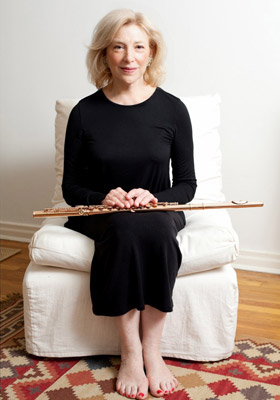Paula Robison displays flute’s power and range with New World Symphony

Paula Robison performed works by Leon Kirchner and Michael Tilson Thomas Saturday night with the New World Symphony. Photo: Matt Dine
The popular image of the flute as a gentle, dreamy, pastoral instrument wasn’t much in evidence Saturday as the great American flutist Paula Robison took the stage at New World Center in Miami Beach.
In a performance with the New World Symphony, she played works by Leon Kirchner and Michael Tilson Thomas that showed what a vast range the instrument can have in the right hands. Her flute snarled, it chirped, it buzzed, it faced down an orchestra augmented with extra percussionists. And it also played in the classic flute manner, as she smoothly performed melodies of Tilson Thomas that drew on the wistful, impressionistic quality that seems to be the flute’s private property.
Robison has worked with Kirchner, who died in 2009, for decades, and he wrote his Music for Flute and Orchestra for her in 1978. Making no concessions to the ability of her instrument to be heard, Kirchner scored it for a huge orchestra that included six percussionists and an electric piano.
The size of the orchestra added to the work’s drama. The ensemble would produce dark and grandiose sounds, with rattling percussion and soaring brass. And Robison would enter with the flute’s single ribbon of sound, but playing with such force, virtuosity and intensity that her swift moving lines and bits of melody easily penetrated the surrounding sound.
Tilson Thomas’ Notturno was also composed for Robison. This unpretentious work is modeled on the 19th-century salon pieces with which virtuoso musicians used to charm audiences. The work seems to travel backward in time as it progressed, opening with Robison performing poignant melodies that resembled French impressionism and ending up with tunes that recalled 19th century Italian opera—though the abrupt and violent tones near the end bring the music firmly into the 21st century.
The concert opened with Beethoven’s Egmont Overture, under the baton of conducting fellow Christian Reif. Conducting without a score, he led a grimly effective, finely paced performance, holding the orchestra back enough to make room for ferocious crescendos.
After intermission came the Sibelius Symphony No. 3. Compact and based on simple motifs, this has been called Sibelius’ most classical symphony, a well-proportioned, simply designed structure compared to such sprawling, epic scores as his Second Symphony.
Under Tilson Thomas, the orchestra gave a dramatic, muscular performance. He took the opening Allegro at a quick tempo that brought to the movement unusual force and momentum. The musicians played with great clarity despite the high speed, with strings in particular bringing crisp precision to the fast, running passages with which the movement abounds.
The simple melody of the second movement was played with glowing warmth by clarinets and flutes. In the third and final movement, Tilson Thomas and the orchestra created a great sense of expectation, as the movement surged toward the final melody—first heard quietly in the violas—and built to a resonant and booming musical affirmation.
As an encore, they performed Sibelius’ Valse Triste, giving a light but silken-toned performed that captured the dance-like quality that eludes some performances.
The program will be repeated 2 p.m. Sunday at New World Center in Miami Beach. nws.edu, 305-673-3331.
Posted in Performances
Leave a Comment
Sun Feb 22, 2015
at 11:56 am
No Comments